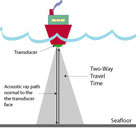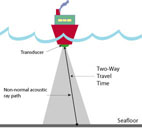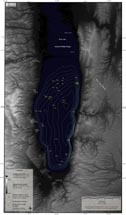Geophysical Surveys of Bear Lake, Utah-Idaho, September, 2002, OFR 03-150
|
OF 03-150 Home CD-ROM Contents Project Description
Contacts |
Data
|
||||||||||||||||||||||||||||||||||||||||||||||
When acquiring bathymetric data, the time of travel of
an acoustic wave from the transducer to the seafloor and back (two-way
travel time) is measured; depth is not directly measured. In order to convert
Eighteen sound velocity profiles were collected throughout Bear Lake using an Applied Microsystems SVP Plus sound velocimeter. The locations of the profiles are displayed within Figure 4. Thumbnails of the sound veloicty profiles are listed below. Click on a thumbnail to view a full resolution version of the sound velocity profile. These data are also stored within the ArcView project file and as an MS Excel spreadsheet in the svp directory. See GIS Data and CD Contents for more information.
| |||||||||||||||||||||||||||||||||||||||||||||
To view files in PDF format, download free copy of Adobe Acrobat Reader www.adobe.com/products/acrobat/alternate.html.
Title Page / Contents / Project Description / GIS Data / Contacts
[an error occurred while processing this directive]




















